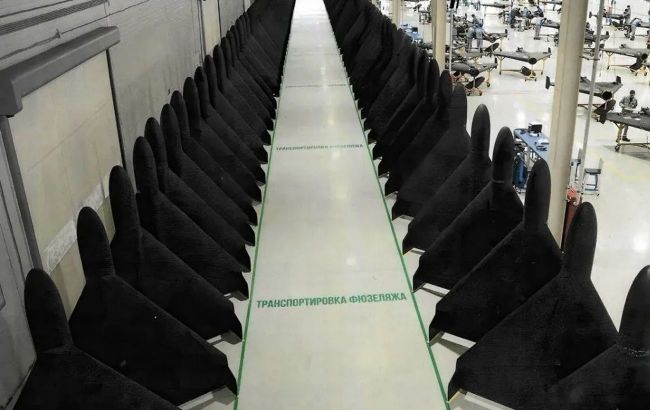Russia ramps up weapons production: The Economist shows scale in charts and figures
 The Economist revealed scale of Russia's surge in weapons production (Illustrative photo: Russian media)
The Economist revealed scale of Russia's surge in weapons production (Illustrative photo: Russian media)
The increase in Russian drone attacks on Ukrainian territory indicates the hyperactive activity of Russia's defense industry, reports The Economist.
The media outlet based its calculations on data analysis from various, mostly commercial sources. In particular, it estimated the number of electronic devices — such as mobile phones — present at Russian industrial facilities.
These data represent only a portion of the total number of devices — possibly between 2% and 10% — but they serve as an indicator of the level of activity among Russian workers.
Tank factories
The Omsk Tank Plant is one of the largest tank factories in Russia. This facility receives old T-80 tanks, produced decades ago, and upgrades them, operating around the clock.
It is known that activity at Omsktransmash slightly increased before Russia's invasion of Ukraine in February 2022, but then declined afterwards. However, after the full-scale invasion, the number of personnel at the plant sharply increased. The level of activity has remained particularly high since mid-2023.
However, after the full-scale invasion, the number of personnel at the plant sharply increased. The level of activity has remained particularly high since mid-2023.
According to the media outlet, a similar pattern can be observed across Russia's defense-industrial facilities.
Meanwhile, Uralvagonzavod, Russia's largest tank factory, has shown significantly higher activity in 2024 compared to 2023. The Arzamas plant, which produces armored personnel carriers, and the Kurganmashzavod and Motovilikha plants, which manufacture infantry fighting vehicles, are also experiencing a boom.

Artillery
According to The Economist, the Yekaterinburg Plant No. 9 manufactures barrels for howitzers and tanks. Satellite imagery reveals artillery pieces and cannons parked in the open air. Just a few kilometers away is the Novator facility, which develops Iskander ballistic missiles.
In addition, there are signs of significant growth at the Titan-Barrikady plant in Volgograd, where Iskander launchers are produced, and at the Splav research and production association in Tula, which manufactures Grad, Uragan, and Smerch rockets.

Explosives
Producing three million shells per year requires vast quantities of explosives. The largest facility in Russia for their production is the Sverdlov Plant in Dzerzhinsk, which specializes in manufacturing chemicals for artillery shells and guided aerial bombs. In recent months, output at this plant has increased significantly.
Julian Cooper, an expert from the University of Birmingham, noted that heightened activity has also been observed at the Selmash facility in Kirov, where ammunition casings are produced.

Drones
The increase in Russian drone attacks on Ukrainian territory reflects the hyperactive pace of Russia's defense industry. In particular, this aligns with rising activity at the Alabuga plant in Tatarstan, where these drones are manufactured, and at the nearby Begishevo airport.

These are not the only signs of Russia's rapidly intensifying defense industry. The Economist has observed several other indicators. For example, in Biysk, home to a key oleum production facility used in explosives and a military research center, there has been a notable increase in activity. In 2023, average daily traffic between residential zones and chemical plant areas rose by 19%. Additionally, the "dwell time" — how long people remain in one location — increased by 32% during periods associated with second and third work shifts.
The Strava fitness app, which tracks physical activity, revealed the emergence of new groups of runners and cyclists in areas near these industrial sites. This suggests an influx of new workers to the region, which could also explain the 21% year-on-year increase in local rental prices.
Despite the surge in activity, Russia's industry still faces certain limitations. Last year, the country relied heavily on North Korea for a significant portion of the artillery ammunition used in Ukraine — but those supplies are not unlimited.
Previously, we reported that Russia is producing ammunition at an "extraordinary pace." The Economist has also uncovered the annual production volumes for Iskander and Kh-101 missiles.

